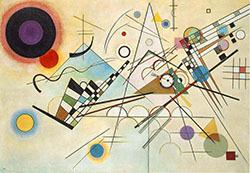 Abstractionism is a avant-garde art movement in which the representation of reality is made in a deconstructed way, using colors, lines and abstract shapes.
Abstractionism is a avant-garde art movement in which the representation of reality is made in a deconstructed way, using colors, lines and abstract shapes.
Also called Abstract art, there are records of this art form from prehistory. But the concept of Abstractionism was consolidated in the beginning of the 20th century, with the beginning of the movement led by Wassily Kandinsy.
The arrival of the abstractionist movement breaks all and any concrete reference at once. everything is abstraction in the works, as if they were creating a parallel reality, an abstract autonomous universe in which lines, shapes and colors are not what is seen. This idea can be summed up in Kandinksy's phrase, "to create a work of art is to create a world".
The abstractionist movement has great influence among artists of the 20th and 21st centuries, involving within the concept of Abstract Art other artistic currents such as Expressionism, Cubism, Dadaism, Futurism, Surrealism and Neoplasticism.
See too: characteristics of expressionism and The Types of Art.
Top Artists of Abstractionism
Wassily Kandinsy, Piet Mondrian, Jackson Pollock, Paul Klee and Robert Delaunay.
The Japanese artist based in São Paulo Manabu Mabe was the precursor of the abstractionism in Brazil, followed by Tomie Ohtake, Cicero Dias and Antonio Bandeira.
Characteristics of Abstractionism:
- Representation of the world disconnected from visible reality
- Denial of the figurative and imitation of the world
- Deconstruction of natural figures
- Simplification of form
- Innovation in the use of color
- perspective rejection
- Opposition to conventionally portrayed lighting
Historical Context of Abstractionism
The abstractionism movement emerged in opposition to the Renaissance notion of art and beauty, still in force at the time. In the Renaissance, the artist's talent was measured by his ability to reproduce the world around him as truthfully as possible.
There are authors who also defend that the popularization of photography, in the late nineteenth century, contributed to the emergence of abstract art, since it was no longer necessary for art to act as an imitation of the world.
The impressionists of the late 19th and early 20th centuries, such as Monet, who had already begun the search for the representation of the universe from other perspectives. The Impressionists' concern was with luminosity, much more than the perfect impression of the objects or people represented.
At the beginning of the 20th century, two styles emerged that began to break with the idea of imitating nature, making room for the advancement and consolidation of abstract art. Henri Matisse's Fauvism was dedicated to the simplification of forms and an accurate study of colors. The Dadaism of Pablo Picasso and Georges Braque decomposed the perspective of scenes and used geometric figures in the representation of the elements of nature.
Informal Abstractionism
Within Abstractionism, one strand identified itself more with the transmission of feelings and emotions through art. What became known as Informal Abstractionism, or Expressive Abstractionism, or even Lyrical Abstractionism. Artists identified with this group worked even more with their subjectivity, translating a strong emotional charge in the works through colors and shapes freely interpreted, by instinct. Its greatest representative was the Russian painter Wassily Kandinsky.
Geometric abstractionism
While informal abstractionism was concerned with emotion, the focus of geometric abstractionism was form. The elements of the works, their colors and lines, formed geometric compositions. The artist who stood out the most in this field was the Dutch Piet Mondrian.
You may be interested in the meanings of Cubism, futurism and Abstract art.
